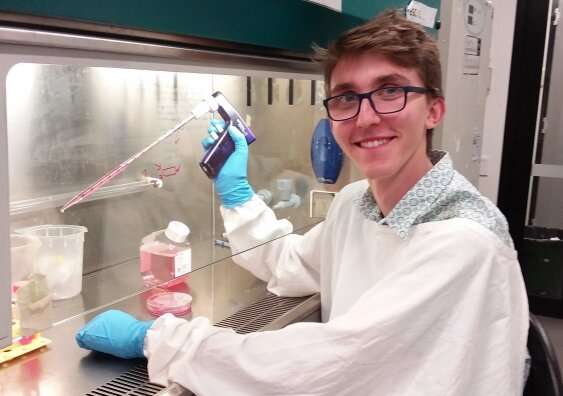UNSW PhD Student Hudson Coates, an author on a paper that shows how a key enzyme that contributes to cholesterol production can be regulated by the ‘shark molecule’ squalene. Credit: UNSW
A team of scientists have shown in cell lines that a key cholesterol synthesis enzyme—squalene monooxygenase (SM) – is controlled by the levels of its target molecule, squalene. The findings, published in international journal PNAS, have implications for the development of cholesterol-lowering drugs.
The research paper's co-lead author Professor Andrew Brown at UNSW Science says squalene is highly abundant in our skin, and it's often used as an ingredient of cosmetic products.
Squalene owes its name to Squalus, a type of shark that—like all sharks—needs squalene-enriched livers for buoyancy. Indeed, squalene was first isolated from shark liver oil in 1916 by Japanese researchers. Today, it is obtained from plant sources and synthetically, too—for example, high levels of squalene are found in olive oil.
"In the paper published today, we showed in cell lines that when the levels of squalene increase, it interacts with squalene monooxygenase and protects it from destruction. This ensures that there is enough enzyme available to efficiently convert the excess squalene to cholesterol," Professor Brown says.
"That's an important finding, because it is essential to understand the factors that control the rate of SM destruction, so as to enable the development of drugs targeting this enzyme and its activity in cardiovascular disease and cancer."
Potential for drug development
Squalene monooxygenase plays an important role in the production of cholesterol. For nearly 20 years, it has been proposed to be an enzyme in the pathway which should be investigated as another drug target to lower cholesterol, with this research adding another piece to the puzzle.
While cholesterol is an essential component of the membranes that enclose all of our cells, it also has well-established links with cardiovascular disease and, in recent years, the onset of cancer. The overactivity of squalene monooxygenase itself can promote the growth of some cancer cell types, and excess squalene may enable this overactivity by protecting SM from destruction.
"Our results show that by binding squalene, SM can sense cellular squalene levels and adjust its activity accordingly.
"Knowing how to regulate SM may, therefore, offer a new way to control its abundance and also help with lowering cholesterol levels," Professor Brown says.
Professor Brown's laboratory previously showed that a build-up of cellular cholesterol leads to the destruction of SM, helping to shut down cholesterol synthesis when it is not needed.
"Now, we have found that a build-up of squalene has the opposite effect—protecting SM from destruction. It appears that the levels of this important enzyme are controlled by a tug-of-war between precursor and product molecules," Professor Brown says.
Future research: squalene monooxygenase and our metabolism
Professor Brown's lab wants to keep investigating the role of squalene in SM regulation.
"Previous studies have found that excess squalene is stored in specialised cell compartments called lipid droplets," Professor Brown says.
"Next, we aim to investigate if active SM is also found in these compartments. This could have important implications for the control of metabolism, since lipid droplets are a major way in which cells such as adipocytes store fats for energy."
Today's paper was the result of an international collaboration with researchers from the University of Tokyo, Hiromasa Yoshioka and co-lead author Kenji Ohgane. UNSW Ph.D. students Hudson Coates and Jake Chua were heavily involved. The study is the first reported example of a substrate binding to and protecting its associated enzyme from degradation independently of the enzyme's chemical activity.
More information: Hiromasa Yoshioka et al. A key mammalian cholesterol synthesis enzyme, squalene monooxygenase, is allosterically stabilized by its substrate, Proceedings of the National Academy of Sciences (2020). DOI: 10.1073/pnas.1915923117
Journal information: Proceedings of the National Academy of Sciences
Provided by University of New South Wales























